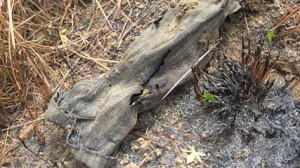MONROVIA, Liberia — On Wednesday, Liberians will honor the memory of two former presidents, William Tolbert and his successor, Samuel K. Doe, slain during two decades of fighting that started with a 1980 military coup.

The exact whereabouts of the ex-presidents’ remains is unknown. Both men were tossed into mass graves along with thousands of others put to death in Liberia’s grisly war, and their bones could be among the many fragments being found there.
Liberia, a West African nation the size of Tennessee, was formed by freed U.S. slaves in the 19th century. Ellen Johnson Sirleaf was elected president in 2005 after 14 years of civil unrest.
Now, seven years after fighting ended, bones are surfacing all around Liberia’s capital. Liberians come across bones while playing soccer on the beach or digging their garden plots. Thousands who died were buried in shallow graves or tossed onto the beaches, left to decompose under the hot equatorial sun.
Jackson Gbeyor, an ex-combatant who lives near an army training center, says he and his friends find bones on the beach behind the barracks. “Sometimes you will see some bones rooted out. Sometimes when we’re playing football, we search for bones and take [them] out,” Gbeyor says.
Isaac Weede, 57, a construction worker in Lakpazee, West Point, a section of Monrovia, shows a reporter dozens of skulls and bones at the bottom of the James Spriggs Payne airstrip where he lives. Residents call it the graveyard. At the end of the runway, the remains of those buried in mass graves have become visible after years of erosion. A bone that appears to be a femur juts out of the sand, among tattered clothing and bullet casings.
“This whole place is covered with bones,” Weede says, gesturing toward the swamp that surrounds the airstrip. Weede and his neighbors buried bones in 1991, but fresh remains continue to surface. “Even last week when I was digging in my garden, I found a bone and threw it in the swamp.”
“We will feel very happy if the international community or our government were to come and have a reburial,” he says.
David Targbe, news director at the Catholic Church-run Radio Veritas, escaped the armed force’s bullets in a firing line in West Point.
“Even before that night, there were a lot of mysterious killings, secret killings. … You’d see pickups loaded with human beings. They’d come back empty. They’d make these trips three, four, five times a day,” Targbe says.
“If we could have a national day, a memorial in honor of those who lost their lives, that would be OK,” he says.
Human rights experts and survivors say the time has come for a collective burial. Mass graves have been reopened and remains reburied after wars in Rwanda, Spain, Bosnia, Iraq and elsewhere. It’s an expensive undertaking but one that is worth the investment, advocates say.
“It takes a lot of preparation and a lot of money to do these excavations, but first and foremost we have to identify them,” says Leroy Urey, chairman of the Independent National Human Rights Commission. “We have to find all the people who were executed, all those who were tied to the pole and shot and slaughtered and dumped into mass graves.”
President Johnson Sirleaf’s spokesman, Cyrus Badio, says there are no immediate plans to excavate the graves.
Jerome Verdier, chairman of the erstwhile Truth and Reconciliation Commission, says proper burial is an important part of the reconciliation process.
“Our people’s traditional and religious beliefs are tied to the proper burial of our loved ones,” he says. “It’s a way of remembering them, and it’s a way of ensuring that they rest in peace.”
The violence that began in Liberia in 1989 quickly turned into an ethnic conflict, with the armed forces loyal to Doe, of the Krahn tribe, targeting members of the Gio and Mano tribes. The conflict began when non-commissioned officers, including Doe, executed President Tolbert and his cabinet, dumping the bodies into a mass grave, in a military coup that upended more than a century of single-party rule.
The armed forces under Doe carried out thousands of executions in Monrovia in 1990 as it sought to eliminate rebel factions; an estimated 250,000 lives were lost. Doe was later executed by a rebel faction controlled by former warlord and current Senator Prince Johnson. Thousands more were killed during the regime of Doe’s successor, Charles Taylor, now on trial at The Hague for alleged war crimes in neighboring Sierra Leone.
Verdier’s commission has identified about 100 sites of mass graves in the capital, but only a handful has been investigated.
“Monrovia alone has nearly 100. The report catalogs nearly 200 around the country. There were killing fields and we discovered some, we identified them,” Verdier says.
Citizens and survivors say they want the bones to be exhumed and buried for good, closing a chapter in Liberia’s recent violent history.
Mayoupleh Jeffley, 39, lives at Duport Road on the outskirts of Monrovia, where an estimated 200 people are buried. Some of the remains came from a 1994 massacre, when Taylor’s National Patriotic Front of Liberia set a community aflame, killing 48. Talk has begun about honoring the dead.
“[We’re] planning but the time hasn’t come yet,” Jeffrey says. “Anytime we can all get together we will do it. We will call all the Liberian people because the people that [are] under this ground … are not at rest.”
